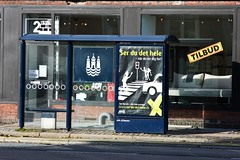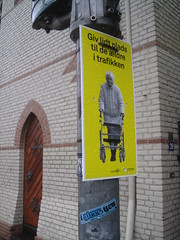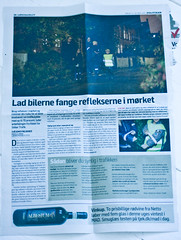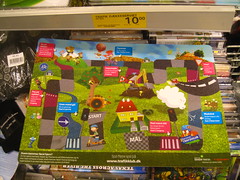
Reading the first part of the book Fighting Traffic - The Dawn of the Motor Age in the American City has been an uplifting experience. It's fascinating to read how 'the street' that had been a space for people since cities first were formed was defended so passionately by citizens in the first quarter of the 20th century when cars started their domination. Inspiring to learn that people didn't just shrug in resignation but rather fought tooth and nail to preserve our liveable cities.
Sigh.
After you rise high it is farther to fall. There is a constant flow of mad proposals from around the world. Things like Banning earbuds for pedestrians and cyclists (but as BikePortland put it, that's a bit mad when the deaf are allowed to cycle - and walk around cities) and banning children as passengers on bicycles.
What amazes me is that I don't need to travel to get depressed and frustrated. It's all around us here in Copenhagen and Denmark. It's high season for fear merchants unanimously backing the automobile horse and continuously sticking a broomhandle in the wheels of bicycle culture, development of liveable cities and rationality.
Here's a round-up of the 'safety campaigns' we've seen over the past few months in Copenhagen. Above, the banner reads: "He listened to music and died in traffic. Traffic demands all your senses..." It's hanging boldly over the street as a confirmation to all motorists that it's not their fault. The bulls may run free in the City of Frederiksberg.

Here's another one from the same series. "She texted, and died in the process..." This is second year in a row this campaign has been used - which is probably a testament to lack of creativity rather than budget restrictions.


Another repeat performer are these walking hazards - stickers warning pedestrians that this city prioritizes cars and that all responsibility lies with those who choose 'old-fashioned' forms of transport. Apparently the people behind this campaign have calculated that pedestrians tripping over their stickers would be an extra behavourial ruler-on-the-knuckles for the naughty walkers so sub-standard glue was used.

These pictograms on our cycle tracks showed up last year and we wrote about this Car Friendly Campaign in Copenhagen. As mentioned in the previous article there was no corresponding campaign for motorists, which is the case with all of these fearmongering campaigns. Which, by default, reduces the already low levels of credibility of these campaigns to almost zero.

On this busstop, and all over town late last year, a new campaign was hyped called Ser du det hele? - Are you seeing everything?. It was yet another campaign going after pedestrians, with focus on youths. Here's the website wherein they cement the dominance of automobile traffic - and the folly of even thinking that something could be done to restrict the destructive capabilities of cars - with a couple of films. The campaign is a product of Byens Trafikråd - City Traffic Council and with taxpayers money they show the world precisely how not to market liveable cities and rational safety campaigns.

With THAT said, this is one of the few campaigns that are rather neutral. "Give a little bit of space to the elderly in the traffic". Simple, to the point, no safety nanny finger-wagging.

Which brings us to the Danish Road Safety Council - Rådet for Sikkertrafik (eller Rodet for Sikkerpanik) who have been ignoring the bull for decades. The title on the magazine cover, above, reads Watch Out! We've blogged about this vintage bull ignoring before. Even back in the 1950's they were protecting motorists by promoting reflexes for pedestrians and cyclists instead of working intelligently to reduce traffic dangers.
It's shocking and rather distasteful that a non-elected council wields such great influence in a democracy. It's bloody scary. Helmet promotion in Denmark started with these people - no science was harmed in the creation of their campaigns - and now they are revisiting their idea about pedestrians and cyclists wearing reflexes.

Their campaign was launched late last year and, amazingly, featured in many newspapers. As far as I'm aware there is very little science done on the subject of reflective vests - maybe one or two studies. Not that that stops the Safety Council.


I've noticed that The Danish Road Safety Council is now profiting from their fearmongering, selling wares in supermarkets like this family pack of reflective gear at left. At right is a game for children on sale. Indoctrination about how to let cars go about their business.
Aside:
In the Fighting Traffic book I was amazed to learn that playgrounds for children didn't exist before the automobile. There were campaigns for playgrounds in the early part of the 20th century but when the car started muscling its way onto the streets, the call for playgrounds grew. Auto clubs were among the loudest advocates and companies selling playground gear escalated the craze with their marketing. Follow the money.
I'd be interested to hear from readers if Road Safety Councils where you live also profit from selling safety gear. Please add your comments.
I don't think it's appropriate. Insurance companies get involved in safety campaigns for obvious reasons - selling policies. But a Road Safety Council making money? It just feels wrong. Or why don't they just open a car dealership and put all their cards on the table.
Another previous example from Copenhagen - Fear Central is this scary campaign for using lights - compare it to the Dutch way of promoting cycling positively by clicking at the link at the bottom of the the page.
It's no surprise that cycling levels are falling in Copenhagen. Despite the fact that the number of cars on the roads has been historically low over the past couple of years. Despite the hard work of the City of Copenhagen and its Bicycle Office. Despite so many factors.
Fear.
Motordom, through marketing and spin, reversed the negative perception of the automobile in society in the 1920's. Reversing the perception of what streets are for that had existed for several thousand years. The people involved in the above campaigns still have a bag - produced 90 years ago in another country - pulled firmly over their head. They are, it seems, incapable of thinking progressively and their work is a broomhandle in the spokes of the development of Copenhagen as a liveable city where people on foot and on bicycles are placed ahead of machines.


At left: Pedestrian warning at Barcelona Airport - with no corresponding warning for cars.
At right: Sign in a taxi in Abu Dhabi. "Speed limits are for your safety!", it says. 80 km/h?! in cities? My safety?! And, amusingly, 60 km/h IN AIRPORTS.


At left: Earbud bans? What about distracting intelligent pedestrians with overcomplicated texts at crosswalks?
At right: Classic Ignoring the Bull in Society's China Shop in Melbourne. Again, no signs for motorists.
I've just finished the chapter in Fighting Traffic about how the police were the greatest allies for the public in the fight to keep the streets for people. Yes. The police. What a difference a century makes. Not least here in Copenhagen.
Once again, let Copenhagen be an inspiration for cities and towns around the world with regards to infrastructure and bicycle culture but there is no need to look to us for inspiration for promoting cycling positively.